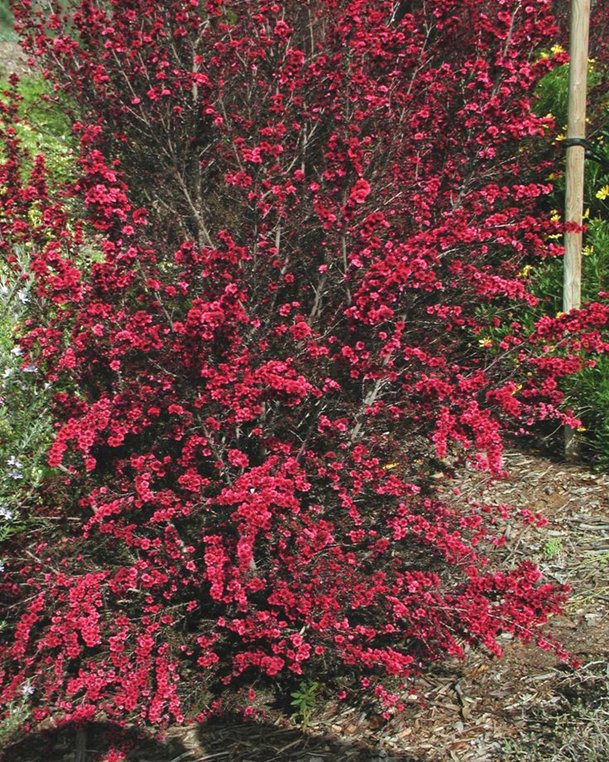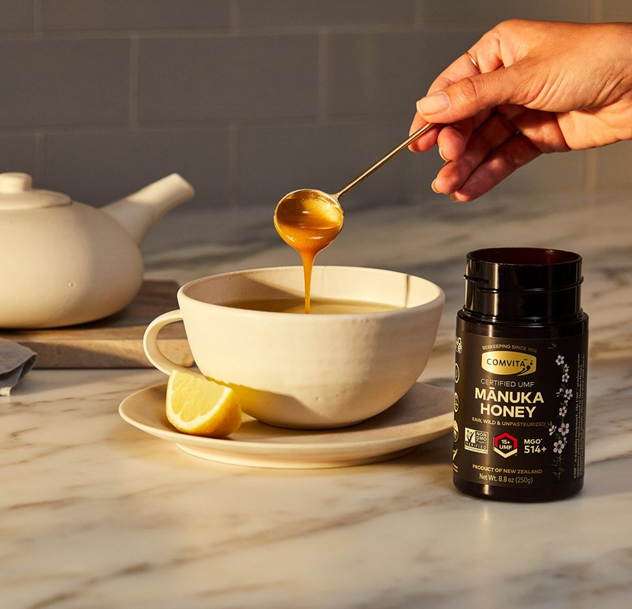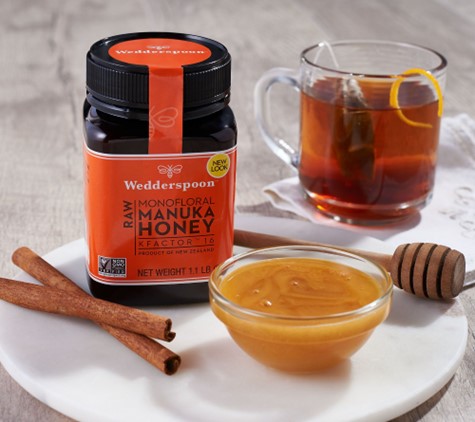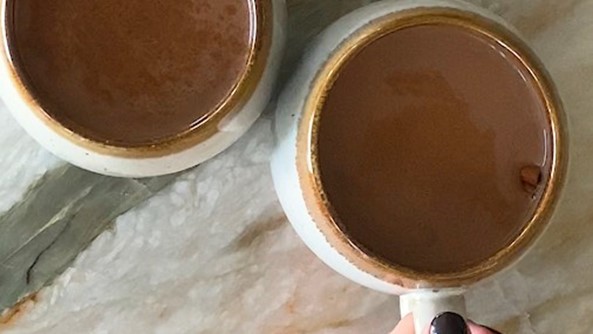Manuka Honey—a Delicious and Healthy “Medicine”
Manuka comes from bees that pollinate the New Zealand Manuka tree. It’s considered a mono-floral honey made from Manuka flower nectar, and is unique from other types of honey because it contains massive amounts of methylglyoxal (MGO) and phenolic compounds.

These substances are associated with rich antioxidant and antimicrobial properties, making this an extremely healthy honey. Its health benefits are remarkable. For instance:
STIMULATES WOUND HEALING: Applied topically, Manuka honey effectively treats burns, ulcers, and non-healing wounds. It has also been shown to combat antibiotic-resistant strains of infections, such as MRSA.
GIVES COUGH RELIEF: Manuka honey can help provide relief from coughs due to upper respiratory tract infections. It may even be more effective at reducing cough frequency and severity than common cough medications.

PROTECTS AGAINST GASTRIC ULCERS: Manuka honey’s potent antibacterial effects help treat gastric ulcers caused by H. pylori. Research is showing it also helps prevent alcohol-induced gastric ulcers.
PROTECTS THE DIGESTIVE TRACT: Inflammatory bowel disease (IBD) is a gastrointestinal tract disease. IBDs, such as ulcerative colitis and Crohn’s can lead to symptoms like diarrhea, abdominal pain, nausea, and vomiting. Studies show that regularly consuming Manuka honey helps control strains of C.diff, a type of bacteria that causes severe diarrhea and inflammation of the bowel.
PROVIDES BETTER ORAL HEALTH: Research shows Manuka honey inhibits the growth of harmful oral bacteria that can cause gingivitis and tooth decay. And unlike refined sugar, it has not been shown to cause tooth decay. I melt a ½ teaspoon of it in 2 tablespoons of warm water and gargle with it once or twice a week during the fall and winter.

All this said, it’s important to note that the amount of MGO in different manuka honeys varies, thus not all manuka honeys necessarily have high levels of antimicrobial activity. The best way to ensure you’re getting a legitimate MGO-filled Manuka honey is to check the product has a CE mark or it’s registered with the Australian Therapeutic Goods Administration (marked with an AUST L/AUST R number).
Manuka honey isn’t necessarily a panacea or a superfood. But it is grossly under-utilized as an effective treatment for cold and flu symptoms, wounds, ulcers and burns, particularly in the face of the “new normal” we’re experiencing concerning global superbugs.

Lastly, because it’s a specialty food, and because it must be imported, it is more expensive than other raw honeys. But a little does go a long way. We keep a jar in our medicine chest and use it as a burn medicine and when we feel a cold coming on. One of our favorite ways to take this “medicine” is in homemade cocoa. With fall here and winter around the corner, you might want to try it. I found this recipe on the site of a renowned Manuka honey grower, www.wedderspoon.com.

2 1/2 cups unsweetened almond millk [Alice’s favorites: 3 Trees and Malk]
2 1/2 tablespoons unsweetened cocoa
1 tablespoon certified Manuka honey
1/4 teaspoon vanilla extract
Directions:
Add Recipe to Cook'n

These substances are associated with rich antioxidant and antimicrobial properties, making this an extremely healthy honey. Its health benefits are remarkable. For instance:
STIMULATES WOUND HEALING: Applied topically, Manuka honey effectively treats burns, ulcers, and non-healing wounds. It has also been shown to combat antibiotic-resistant strains of infections, such as MRSA.
GIVES COUGH RELIEF: Manuka honey can help provide relief from coughs due to upper respiratory tract infections. It may even be more effective at reducing cough frequency and severity than common cough medications.

PROTECTS AGAINST GASTRIC ULCERS: Manuka honey’s potent antibacterial effects help treat gastric ulcers caused by H. pylori. Research is showing it also helps prevent alcohol-induced gastric ulcers.
PROTECTS THE DIGESTIVE TRACT: Inflammatory bowel disease (IBD) is a gastrointestinal tract disease. IBDs, such as ulcerative colitis and Crohn’s can lead to symptoms like diarrhea, abdominal pain, nausea, and vomiting. Studies show that regularly consuming Manuka honey helps control strains of C.diff, a type of bacteria that causes severe diarrhea and inflammation of the bowel.
PROVIDES BETTER ORAL HEALTH: Research shows Manuka honey inhibits the growth of harmful oral bacteria that can cause gingivitis and tooth decay. And unlike refined sugar, it has not been shown to cause tooth decay. I melt a ½ teaspoon of it in 2 tablespoons of warm water and gargle with it once or twice a week during the fall and winter.

All this said, it’s important to note that the amount of MGO in different manuka honeys varies, thus not all manuka honeys necessarily have high levels of antimicrobial activity. The best way to ensure you’re getting a legitimate MGO-filled Manuka honey is to check the product has a CE mark or it’s registered with the Australian Therapeutic Goods Administration (marked with an AUST L/AUST R number).
Manuka honey isn’t necessarily a panacea or a superfood. But it is grossly under-utilized as an effective treatment for cold and flu symptoms, wounds, ulcers and burns, particularly in the face of the “new normal” we’re experiencing concerning global superbugs.

Lastly, because it’s a specialty food, and because it must be imported, it is more expensive than other raw honeys. But a little does go a long way. We keep a jar in our medicine chest and use it as a burn medicine and when we feel a cold coming on. One of our favorite ways to take this “medicine” is in homemade cocoa. With fall here and winter around the corner, you might want to try it. I found this recipe on the site of a renowned Manuka honey grower, www.wedderspoon.com.

Manuka Honey Cocoa
Ingredients:
2 1/2 cups unsweetened almond millk [Alice’s favorites: 3 Trees and Malk]
2 1/2 tablespoons unsweetened cocoa
1 tablespoon certified Manuka honey
1/4 teaspoon vanilla extract
Directions:
1. Heat up the almond milk in a saucepan on the stove over medium heat (hot, but not boiling); Simmer for 5 minutes.
2. Add the rest of the ingredients and whisk to combine (1 to 2 minutes).
3. Heat for a remaining 1 to 2 minutes before pouring into mugs to serve.
2. Add the rest of the ingredients and whisk to combine (1 to 2 minutes).
3. Heat for a remaining 1 to 2 minutes before pouring into mugs to serve.
Recipe formatted with the Cook'n Recipe Software from DVO Enterprises.
 Alice Osborne
Alice Osborne
DVO Newsletter Contributor since 2006
Email the author! alice@dvo.com
Sources:
- www.pinterest.com
- www.goodhousekeeping.com
- www.lakinaturals.com
- www.qvc.com
- www.wedderspoon.com
